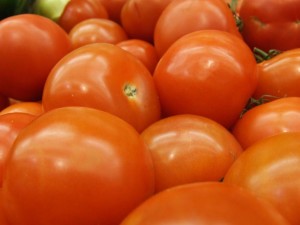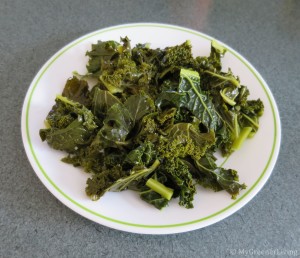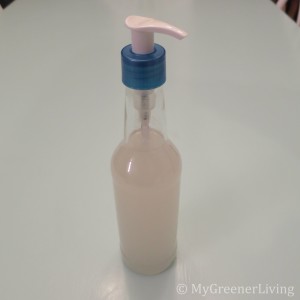
Disclaimer: This post contains affiliate links, which means I may receive compensation if you make a purchase through these links. There is no cost to you. See my Disclosure Policy for more information.
I’m going to be nice and give you the recipe right from the start 🙂
Update 12/1/2016: I now make my liquid soap using potassium hydroxide lye and am much happier with that product. You can see how I make that improved liquid soap here.
Liquid Castile Soap from Bar Soap
How to make liquid castile soap from a bar of castile soap
- 1-4 oz bar castile soap
- 1 tbsp glycerine
- 3/4 gallon 96 oz water
- Optional 1 tsp liquid vitamin E
- Optional a few drops of essential oils
1. Grate the bar soap. You can get a good arm workout in grating by hand with a cheese grater. Or you can chop up the soap into 4-8 pieces, toss in your blender and pulse until you have small crumbles. I used the blender.
2. Pour water into a large pot. Ensure there is at least 2-3 inches between the top of the water and top of the pot. Boil the water for one minute (See Note 1). Turn burner to low.
3. Allow the water to cool for a few minutes, then pour in the grated soap. Gently stir to dissolve the soap into the water. It should dissolve in a minute or two unless you had large chunks of soap. Those took about 5 minutes to dissolve. Turn off the burner.
4. Add the glycerine, vitamin E and essential oils if using. Stir to distribute.
5. Let sit several hours or overnight to cool. The soap will remain very watery, but still works like soap! Some of the soap may separate (cloudy at the bottom of the bottle), just give it a quick shake before using.
6. Pour into your soap dispenser and enjoy!
Note (1): According to the Center for Disease Control, boiling water for 1 minute will make it safe to drink. While I think my tap water it pretty safe (I have been drinking it for 6 years), I boil the water to kill anything that may be living in it, so my soap doesn’t start growing things. If you use distilled water, you can turn off the heat as soon as the water comes to a boil.
Update 4 Jan 2017: I have learned that “real soap” – castile soap and the home made ones without chemicals do not leave that residue on my skin, the sink, the shower…and I now love bar soap.
So, what to do with all this bar soap? Per my usual, I turned to the internet (specifically Pinterest, my weakness). I found a recipe that involved grating up the bar soap and adding it to heated water until it dissolved. I tried it. Worked great! I used this lovely almond scented soap as a hand soap in my bathrooms for a couple months. Then one day I ran out of body wash. Body wash is just glorified liquid soap, right? So why not use this lovely smelling liquid hand soap? BECAUSE YOU’RE ALLERGIC TO EVERYTHING, IDIOT! Well, apparently I forgot about that at the time. Or I thought because it was ok on my hands it would be ok everywhere. But I was very wrong. I got contact dermatitis all over my body (have you ever gotten poison ivy? Yup, it was that reaction). It took over a week for the contact dermatitis to go away. That was not fun, but at least I did this stupid experiment in the winter when it was easier to cover up.
This lovely adventure in discovering a new allergy led me to determine that I needed to get rid of chemicals. I could not handle being allergic to soap. So I turned back to the trusty internet. This time I was smarter, and looked for recipes for fragrance and chemical free soap. And this is when I learned about castile soap. The liquid stuff looked great, but over $15 for 32 ounces? That was not going to be affordable as an every day and and body soap. (I did purchase Dr. Bronner’s unscented liquid castile soap for a face wash and I do really like it.) I immediately went out and bought the first castile bar soap I could find. It was Kirk’s Original Coco Castile, which I found at Walmart.
Kirk’s soap is vegetarian (actually vegan) and contains no artificial ingredients. Ingredients: coconut soap, water, vegetable glycerin, coconut oil, natural fragrance. According to the the FAQ’s page of Kirk’s website, the answer to “What kind of fragrance do you use in your soap?” is “The fragrance is less than 1% of the total ingredients in Kirk’s products. The fragrance is a combination of essential oils from the pine and citrus family and is Phthalate-Free. For those with highly sensitive skin we recommend our Kirk’s Original Coco Castile Fragrance Free Bar.”
Since I have not had sensitivities to and of the listed ingredients, or pine or citrus, I guessed (correctly) that this soap would be safe. It is so gentle that I can, and do, use it on my face.
I use this soap as a hand soap, face soap, body wash, and any time my home made cleaning recipes call for liquid castile soap.
If you’re looking for a super-sensitive liquid soap that is less expensive than liquid castile soap, or just want an inexpensive liquid soap, here’s how to make your own!
Recipe:
1-4oz bar castile soap
1 tbsp glycerine
3/4 gallon (96 oz) water
Optional, 1 tsp liquid vitamin E
Optional, essential oils

Instructions:
1. Grate the bar soap. You can get a good arm workout in grating by hand with a cheese grater. Or you can chop up the soap into 4-8 pieces, toss in your blender and pulse until you have small crumbles. I used the blender.
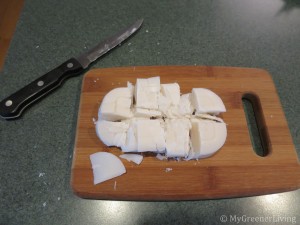
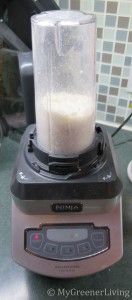
2. Pour water into a large pot. Ensure there is at least 2-3 inches between the top of the water and top of the pot. Boil the water for one minute (See Note 1). Turn burner to low heat.
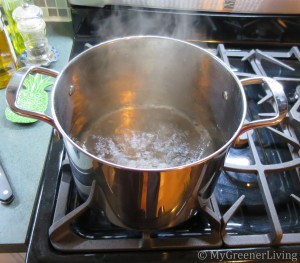
3. Allow the water to cool for a few minutes, then pour in the grated soap. Gently stir to dissolve the soap into the water. It should dissolve in a minute or two unless you had large chunks of soap. Those took about 5 minutes to dissolve. Turn off the stove.
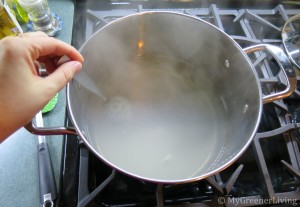
4. Add the glycerine, vitamin E and essential oils if using. Stir to distribute.
5. Let sit several hours or overnight to cool. The soap will remain very watery, but still works like soap! I think it could even be watered down more and be just as effective – I’ll update as I experiment with this.
6. Pour into your soap dispenser and enjoy! If the soap appears to settle with time, just give it a quick flip/shake and it should be as good as new!

Note (1): According to the Center for Disease Control, boiling water for 1 minute will make it safe to drink. While I think my tap water it pretty safe (I have been drinking it for 6 years), I boil the water to kill anything that may be living in it, so my soap doesn’t start growing things. If you use distilled water, you can turn off the heat as soon as the water comes to a boil.
I chose not to add any essential oils due to my skin sensitivity. If you want scented soap, add just a couple drops at a time. You can always reheat soap in small batches and add oils to your smaller batch.
My first try, I used 1/2 gallon (64 ounces) water. After the soap sat in a bottle for a month, it was too thick to pump out of a regular soap or lotion pump. I’ve re-made this soap with more water, and I like it much better.
Odds are you have a hand soap pump bottle in your house. I am all about reusing, so go ahead and keep using what you have! Or, get creative: I have found that some lotion bottle pumps fit on glass beer bottles. The threads on the bottle and cap don’t align quite right so it will leak if turned on its side, but it fits well enough to use.
Insider tip #1: Don’t go adding extras to your whole 1/2 gallon batch of soap. I decided to add that Aveeno Oatmeal bath stuff (which I bought to help with that fun contact dermatitis – works great for that application!). To my whole batch. Thought it would make it softer and soothing. All it does is separate and make my soap cloudy, and clog the pump. And it took me over a year to go through a 96 ounce batch.
Insider tip #2: As you’re making your soap, at step 3, you might think it is a good idea to use your hot water to dissolve the soap that is stuck in your blender. If you chose to do this, please use extreme caution! Because if you fill your blender ⅓ with water, and blend, the entire volume of your blender is instantly filled with beautiful white suds! These suds are pressurized! When you open the blender, warm soapy water will spray everywhere! If the water is too hot, you could burn yourself, and I really don’t want that to happen. If you insist on making a mess, please ensure that the water has cooled first.
Cost breakdown:
Water: $0.0075 (My water rate is roughly $0.01/gallon, so cost here is 3/4 of one cent. I’ll round up to $0.01 for simplicity in this calculation. )
Kirk’s bar soap: $3.28 + 7% sales tax = $3.51 for 3 bars = $1.17
Vegetable glycerine: $2.99 for 4 oz bottle, ½ oz used in this recipe = $0.38
Total cost for 96 ounces: $1.56
I had been paying $3.97 + tax for 56 ounces of store brand hand soap
Mine: 1.625¢/ounce
Theirs: 7.09¢/ounce
Where to buy ingredients:
Kirk’s bar soap can be found in a 3 pack in the soap aisle at Walmart ($3.28 for a 3 pack currently), or on Amazon
Glycerine can be purchased from a pharmacy. It is not prescription, but behind the pharmacy counter. I bought my NOW solutions vegetable glycerine on Amazon because I wanted to ensure it came from vegetable sources.
Vitamin E capsules can be purchased at almost and drug store, grocery store, Walmart, Target, etc. in the vitamin aisle. You can just pierce the gel capsule and squeeze the liquid into the soap. Or purchase liquid Vitamin E on Amazon
Essential oils can be purchased on Amazon (I like NOW brand), or from other companies like doTERRA and Young Living. I have used doTERRA with success as well.
Credits: I got the idea for making liquid soap from a bar from One Good Thing by Jillee.
